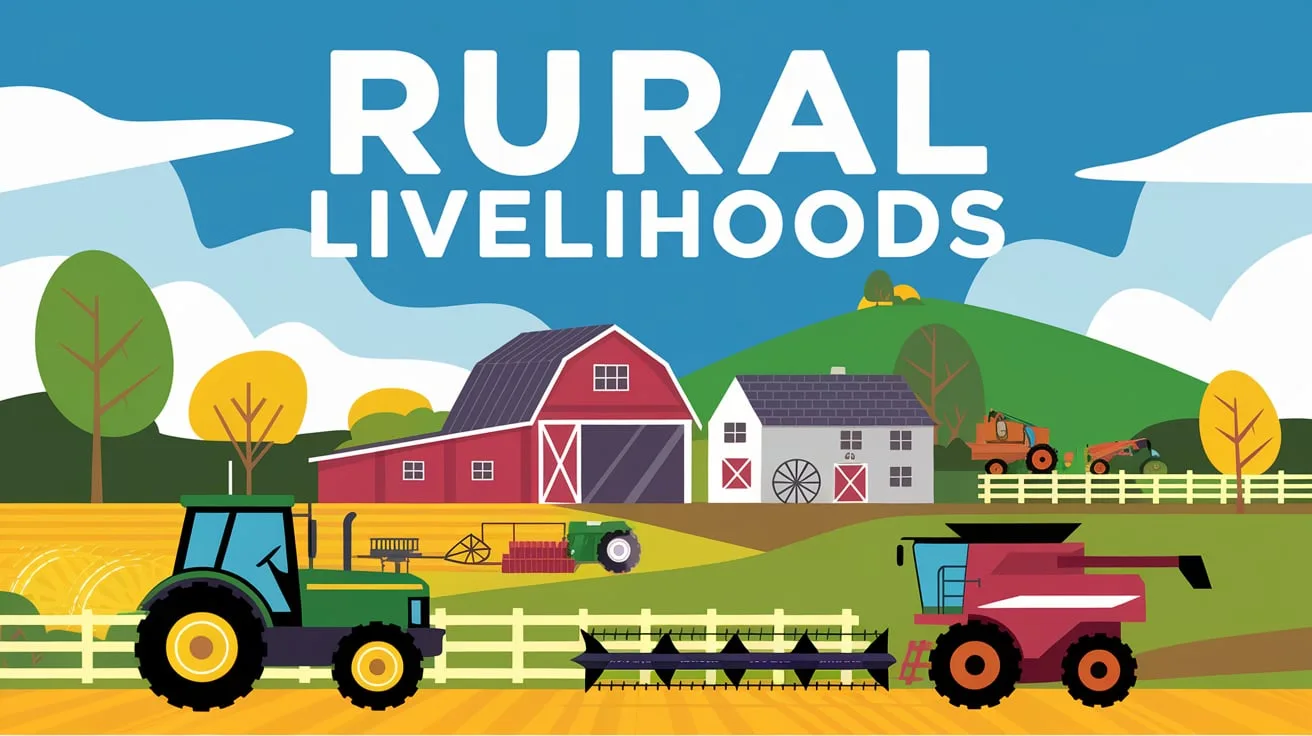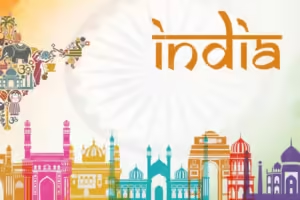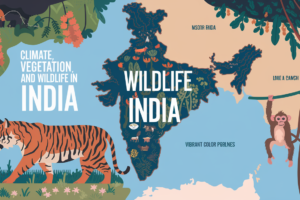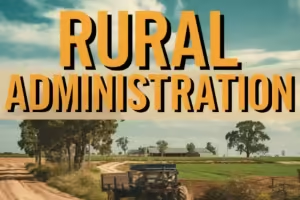
Chapter 8: Rural Livelihoods (CIVICS)
NCERT Solutions for Class 6th Social Science Civics- Rural Livelihoods

People in Villages
Agriculture is the main occupation of the people living in villages. Apart from agriculture, many people are also engaged in non-agricultural activities such as:
-
- Makers of baskets, utensils, pots etc.
- Washer men, barbers, tailors, spinners, blacksmith and weavers.
- Cycle repair mechanics
- Construction workers and lorry drivers
- Shopkeepers selling groceries, snacks and fresh eatables such as upma, poha etc.
- Traders
Agricultural Activities
Most people in villages are engaged in agricultural activities.
- Poor people in rural areas collect firewood, fetch drinking water from long distances and graze their animals. People mostly do these activities to fulfill their household needs.
- In our country, more than two fifth of all the rural families are agricultural labourers.
- Some agricultural labourers own small plots of land while some are landless labourers.
- The landless labourers work on farms of the big land owners on daily wages.
- Working on farms includes activities such as preparing the land, sowing, weeding and harvesting.
- Since landless labourers are not able to find work the whole year round, they travel or migrate to other places in search of work during the lean period.
- In India, about two out of every five rural families are agricultural labourers who work on the farms of big land owners.
- Only 20% of farmers in the country own large lands. These farmers also run small businesses such as small factories, monylending, trading etc simultaneously.

When do Farmers Face the Burden of Debt?
- Many farmers do not always have enough cash to purchase seeds or fertilisers.
- Hence they take loans from moneylender to buy seeds or fertilisers. In case of drought or attack by pests and insects, the crop may fail.
- Under such circumstances, the farmers are not able to repay their loans. In order to survive and feed their families, they again borrow more money.
- The small loan borrowed by them, due to the huge amount of interest, becomes so large, that they become unable to pay the loans and get caught in a debt trap.
- In recent years, the debt trap has become an acute problem due to which many farmers have committed suicide.
Big Farmers and Landowners
In villages there are big land owners. They employ several landless labourers in their fields. At times they may also own a mill which adds to their income. According to the example given in the text, Ramalingam and his family owns a rice mill and a shop which sells seeds and pesticides to the farmers. He usually borrows money from the cooperative bank. The rice produced in the mill is sold to the traders, which earns Ramalingam a good income.

Some Other Activities of People in the Villages
Apart from farming, some other activities of village people are:
- Collection of wood and other forest products like mahua flower, tendu leaves
- Fishing
- Animal husbandry and dairy produce
- Selling of milk to the village cooperative society or in nearby towns.
Important Questions
- Multiple Choice Questions:
Question 1. In the villages most people depend on:
(a) Fishing
(b) Fruit growing
(c) Pickle making
(d) Agriculture
Question 2. One of the major crop failure reason is:
(a) Seeds are not of good quality
(b) Pests attack on crops
(c) Monsoon does not bring enough rain
(d) All the above
Question 3. Which is feature of Chizami village?
(a) People have their own individual fields;
They also work collectively;
(c) They form groups of six or eight
(d) All the above.
Question 4. Thulasi earns per day:
(a) ₹ 40
(b) ₹ 50
(c) ₹ 60
(d) ₹ 100
Question 5. Harvesting season for paddy falls in the months
(a) September-October
(b) November-December
(c) July-August
Question 6. Which is farming activity?
(a) Blacksmith’s work
(b) Weaving
(c) Fishing
(d) Weeding
Question 7. In the village Kalapattu tea shops are:
(a) Three
(b) Four
(c) Five
(d) Six
Question 8. Ramalingam has:
(a) 20 acres of land
(b) 30 acres of land
(c) 10 acres of land
(d) 5 acres of land
Question 9. Nearly ____ of all rural families are agricultural labourers
(a) 3/4th
(b) 2/5th
(c) 2/3th
(d) 1/5th
Question 10. Workers who work on land but do not posses any land is
(a) Landless workers
(b) Land full workers
(c) Land sufficient workers
(d) Landless owners
Question 11. What is the main occupation of people living in rural areas
(a) Working in banks
(b) Working in offices
(c) Working on farms
(d) Working at shops
Question 12. What is the working time in paddy field in Kalpattu
(a) 8.30 am to 7.30 pm
(b) 8.30 am to 4.30 pm
(c) 8.30 am to 6.30 pm
(d) 8.30 am to 5.30 pm
Question 13. There are people in the village provide ___ such as blacksmiths, nurses, teachers , washer men etc
(a) Goods
(b) Services
(c) Non metals
(d) Metal
Question 14. Which of the following is not the sources of livelihood for the people in rural areas
(a) Selling milk in nearby village
(b) Animal husbandry
(c) Fishing
(d) Selling goods in Malls
Question 15. People of Chizami village do ___ cultivation
(a) Jhum
(b) Terrace
(c) Slash
(d) Tree
- Fill in the blanks :
- District Phek is situated in _________ state.
- In India about _________ % of farmers come under small farmers.
- In India nearly _________ out of every five rural families are agricultural labourer families.
- Village Kalapattu is close to the _________ in Tamil Nadu.
- During the monsoon small farmers survive by borrowing from _________.
- Write true (T) or false (F) :
- Thulasi earns Rs 40 per day.
- Thulasi sold her cow to pay back the money she borrowed from Ramalingam for her daughter’s treatment.
- Weaving is a farm activity.
- Sekar has a hybrid cow, whose milk he sells in the local milk cooperative.
- Sekar takes loan from bank and buys seeds and fertilizers.
- Very Short Questions :
- Where is the Chizami village located?
- How much land does Sekar have?
- Fishermen go far into the sea. Why?
- What is special about Chakhesang community?
- What is the main crop that is grown in Kalpattu village?
- How much land does Ramalingam have?
- How do fishermen survive during the monsoon?
- Why did Thulasi borrow money from Ramalingam?
- What kinds of work do agricultural labourers do?
- What work does Sekar do at Ramalingam’s rice mill?
- Short Questions :
- Apart from farming how else does Ramalingam earn?
- What are the main activities of people living near coastal village areas?
- What causes distress among the farmers?
- Write a short on people of Pudupet.
- Thulasi gets paid very little money for the work she does. Why do you think agricultural labourers like her are forced to accept low wages?
- Long Questions :
- Describe the work that Thulasi does. How it is different from the work Raman does?
- Have you heard of tsunami? What is this and what damage do you think it might have done to the life of fishing families like Aruna’s?
- Poor rural labourers like Thulasi often do not have access to good medical facilities, good schools, and other resources. You have read about inequality in the first unit of this text. The difference between her and Ramalingam is one of inequality. Do you think this is a fair situation? What do you think can be done? Discuss in class.
- Write a short note on activities of people of Kalpattu village.
- Why do both Sekar’s and Aruna’s families have to borrow? What similarities and differences do you find?
ANSWER KEY –
- Multiple Choice Answer :
- (d) Agriculture
- (d) All the above
- (d) All the above.
- (a) ₹ 40
- (b) November-December
- (d) Weeding
- (b) Four
- (a) 20 acres of land
- (b) 2/5th
- (a) Landless workers
- (c) Working on farms
- (b) 8.30 am to 4.30 pm
- (b) Services
- (d) Selling goods in Malls
- (b) Terrace
- Fill in the blanks :
- Nagaland
- 80%
- Two
- sea coast
- traders
- Write true (T) or false (F) :
- True
- True
- False
- True
- False
- Very Short Answer :
- Chizami village is in Phek district in Nagaland.
- Sekar owns only two acres of land.
- Fishermen go far into the sea so that they can get a better catch.
- The people of Chakhesang community do ‘terrace’ cultivation.
- Paddy is the main crop that is grown in Kalpattu village.
- He has twenty acres of paddy fields in Kalpattu
- During these months fishermen survive by borrowing from the trader.
- Thulasi borrowed money from Ramalingam for her daughter’s treatment.
- All of them depend on the work they do on other people’s fields to earn a living.
- Sekar helps Ramalingam collect paddy from other farmers in the neighbouring villages.
- Short Answer :
- Ramalingam owns a rice mill and a shop selling seeds, pesticides etc. He buy paddy from within the village and from surrounding villages. The rice that is produced in the mill is sold to traders in nearby towns. This gives them a substantial income.
- People in villages near coastal areas earn their livelihood by fishing. Their houses are close to sea and one finds rows of catamarans and nets lying around. At about 7 a.m. there are lot of activities on beach, this is the time when catamarans return with their catch and women gather to buy and sell fish.
- When crops ruin, farmers sometimes are unable to pay back their loAnd, for the family to survive, they may even have to borrow more money. Soon the loan becomes so large that no matter what they earn, they are unable to repay. This is how they are caught in debt. This has become a major cause of distress among farmers.
- People here earn their living by fishing. Their houses are close to the sea and one finds rows of catamarans and nets lying around. At about 7 o’clock in the morning there is a lot of activity on the beach. This is the time when the catamarans return with their catch and women gather to buy and sell fish.
- Many of agricultural labourers are landless and others may own very small plots of land. All of them depend on the work they do on other people’s fields to earn a living. As there is no other kind of work in the village for agricultural labourers, they are forced to accept low wages.
- Long Answer :
- Thulasi is a labourer who works on Ramalingam’s land. Apart from working on the land, she does all the tasks at home. She cooks food for her family, clean the house and wash clothes. She goes to the nearby forest to collect firewood and she fetches water from borewell which is about one kilometre away.
Raman is also a labourer. During work on farm, he sprays pesticides. When there is no work on the farm he finds work outside, either loading sand from the river or stone from the quarry nearby.
-
- Yes, I heard of tsunami. Tsunamis are giant waves caused by earthquakes or volcanic eruptions under the sea. When tsunami waves become extremely large in height, they savagely attack coastlines, causing devastating property damage and loss of life. Tsunami waves destroy boats, buildings, bridges, cars, trees, telephone lines, power lines – and just about anything else in their way. The violent force of the tsunami results in instant death, most commonly by drowning. Fishing families, who live near the coast, may have lost their house and lives.
- This is not a fair situation:
- Government should put ceiling on land. This will lead to distribution of surplus land among the landless labour.
- Government should made primary education compulsory to all in villages. This will help people to know about their rights.
- Kalpattu is a village that’s close to the sea coast in Tamil Nadu. The village is surrounded by low hills. Paddy is the main crop that is grown in irrigated lands. Most of the families earn a living through agriculture. Apart from agriculture, people do non-farm work such as making baskets, utensils, pots, bricks, bullock-carts etc. There are people who provide services such as blacksmiths, nurses, teachers, washer men, weavers, barbers, and cycle repair mechanics and so on. There are also some shopkeepers and traders. In the main street, which looks like a bazaar, there are variety of small shops such as tea shops, grocery shops, barber shops, a cloth shop, a tailor and two fertiliser and seed shops. There are some coconut groves around.
Cotton, sugar cane and plantain are also grown, and there are mango orchards. There are agricultural labourers also who works on people’s fields to earn a living.
- Sekar’s family has to buy seeds and fertilizers as a loan. To pay back this loan they have to sell their paddy to him at a somewhat lower price than what they would get in the market. During monsoon season, Aruna’s family has to borrow money from the traders as they cannot go to sea. Because of this, later on they are forced to sell the fish to that trader, and cannot do their auction.
Similarities:
- Both have to work very hard to earn their living.
- Both are under the clutches of the traders, from whom they have borrowed money.
Differences:
- Sekar is a small farmer who own only two acres of land and Aruna is a fisherwoman.
- Sekar earns some extra money by working in Ramalingam’s mill. Aruna sells fish only.



